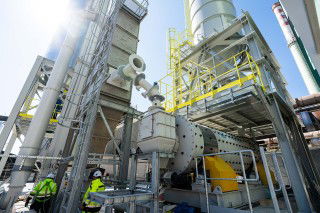As a leading industrial nation in the EU, Germany's carbon capture utilisation and storage (CCUS) strategy is key for the succesful reduction of European CO2 emissions. The German government has targeted net zero to be reached in 2045 and the cement sector is expected to play an important part in this drive. Progress is underway with cement industry CCUS projects at Mergelstetten and Rohrdorf featuring in the news. However, there is a concern about adequate underground storage of captured CO2 being available and the need for cross-border transportation to make Germany's net-zero aspirations become a reality.
Positive announcements from the Catch4climate initiative and the ANDRITZ-led Rohrdorfer CCUS project, indicate that Germany is well advanced in its plans to decarbonise its cement sector. This looks particularly true of the Rohrdorfer project that started its carbon capure and utilisation (CCU) facility this month and intends to use the captured carbon in the food sector. The cement plant aims to be climate neutral by 2038 when it targets to capture 1500tpd of CO2. A second CCU plant at the site is already being planned. Similarly, the Catch4climate project at Schwenk Zement's Mergelstetten cement plant is on schedule to be commissioned in mid-2024 and the captured carbon will be used for the production of 'reFuels', a synthetic fuel for air travel.
While end use of the captured carbon has been identified for these projects, the growing number of steel, cement and lime plants seeking end-markets for captured CO2 is expected to rise. Germany is already piloting several CCU projects for the cement sector. Dyckerhoff (Buzzi Unicem) is working with Advanced Indirectly Heated Carbonate Looping Process to install the ANICA pilot plant at its Göllheim plant in Germany. CEMEX Rüdersdorf is planning to produce jet fuel from its 100tpd CCU plant with Carbon Clean and KBR, before scaling up to capture 2000tpd of CO2. Holcim’s 'Carbon2Business' scheme at its Lägerdorf plant is part of the Westküste 100 CCUS project that will use the oxyfuel process to capture 1Mta of CO2 from 2029 to supply the chemical industries. Heidelberg Materials' Hanover cement plant is also to be the demonstration plant for capturing 100,000tpa of CO2 by 2025 in partnership with Calix and a European consortium of companies (LEILAC). Furthermore, the AC2 OCem project will have the European Cement Research Association (ECRA) select two European cement plants for the oxyfuel pilot studies which may well be located in Germany.
Carbon management strategy
While the cement sector is advancing its CCU and CCUS processes, this is not the end of Germany’s actions to deal with CO2 emissions. Following the German Federal Ministry of Economics and Climate Protection's evaluation report on the Carbon Dioxide Storage Act (KSpG) in December 2022, the German government is keen to develop a Carbon Management Strategy. The strategy will consider CO2 storage and utilisation going forward and to establish a clear framework for the accounting of negative emissions. It is estimated that 30Mt of CO2 will still need to be captured, transported, reused or disposed of in final storage in 2045, even after climate neutrality has been achieved, according to T45 forecasts by Langfristszenarien. It is essential for not only industrial sites for CCUS to be identified but also to locate capture and utilisation hubs, as well as transport routes and pipeline infrastructure for captured CO2 and storage locations.
"Putting CO2 under the ground is quite simply better than releasing it into the atmosphere," said German Vice Chancellor, Robert Habeck. "For this reason, Germany is now working on a carbon management strategy in order to create the legislation for the use of such technologies in this year, by mid-2023."
Reaching net zero
In the long-term decarbonisation forecasts, such as Langfristszenarien's model scenario, clinker factor will fall slowly and only by a small percentage from 73 per cent in 2020 to 67 per cent in 2045 in Germany. New binders are only expected to account for 10 per cent of German cement production by 2045. So carbon capture will play a significant role in reducing Germany's cement sector emissions. Clinker production without CO2 separation will fall from 25Mt in 2025 to 14Mt in 2035, before reaching zero in 2045. Simultaneously, clinker production in Germany with CO2 separation will steadily grow from 1Mt in 2025 to 4Mt in 2030, and 9Mt in 2035, before reaching 21Mt in 2045.
While industrial clusters of CCUS sites are expected to be available in core German basic and heavy industrial areas, direct carbon removal from the atmosphere is still expected to be required to offset any greenhouse gas emissions that continue to occur after 2045, for example, from agriculture. Analysts Carboneer suggest that in 2045, Germany must have the capacity to directly remove from the atmosphere 10 per cent of the greenhouse gas emission levels the country emitted in 2020 to reach its net zero CO2 target.
